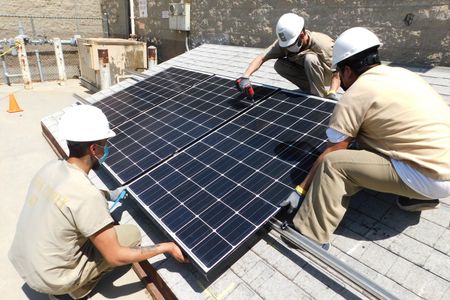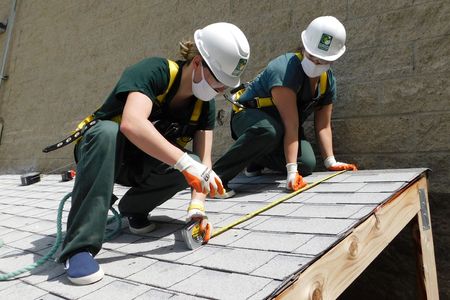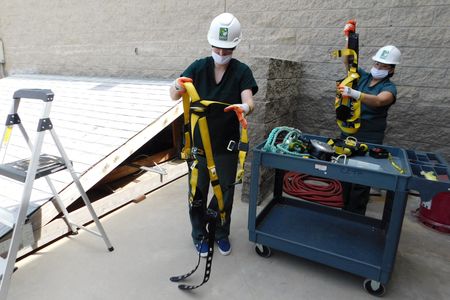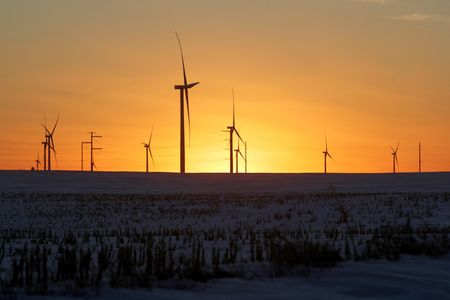By Nichola Groom and Valerie Volcovici
(Reuters) -U.S. clean energy companies are offering better wages and benefits, flying in trainers from overseas, and contemplating ideas like buying roofing and electric repair shops just to hire their workers as firms try to overcome a labor shortage that threatens to derail President Joe Biden’s climate change agenda.
The Inflation Reduction Act, signed into law last year, provides for an estimated $370 billion in solar, wind and electric vehicle subsidies, according to the White House. Starting Jan. 1, American consumers can take advantage of those tax credits to upgrade home heating systems or put solar panels on their roofs. Those investments will create nearly 537,000 jobs a year for a decade, according to an analysis by BW Research commissioned by The Nature Conservancy.
But with the U.S. unemployment rate at an historic low of 3.5%, companies say they fear they will struggle to fill those jobs, and that plans to transition away from fossil fuels could stall out. Despite layoff announcements and signs of a slowdown elsewhere in the economy, the labor market for clean energy jobs remains tight.
“It feels like a big risk for this expansion. Where are we going to find all the people?” said Abigail Ross Hopper, president of the Solar Energy Industries Association trade group.
The shortage is anticipated to hit especially hard in electric vehicle and battery production and solar panel and home efficiency installations, forcing some of the companies into bold new approaches to find workers.
Korea’s SK Innovation Co Ltd, which makes batteries for Ford Motor Co’s F-150 Lightning all-electric pickup truck in Commerce, Georgia, has pumped up pay and benefits as it ramps up its U.S. workforce to 20,000 people by 2025 from 4,000 today.
The battery maker is advertising pay between $20 and $34 an hour, above Georgia’s median hourly wage of $18.43, according to the U.S. Bureau of Labor Statistics. It is also covering 100% life insurance costs and matching retirement plan contributions up to 6.5%, above the national average of 5.6%, according to the Plan Sponsor Council of America. And the company is providing free food on the job.
“Georgia’s talent pool is not really massive. But we are trying to improve some of our policies to better source and retain workers,” said an SK official who declined to be named, citing the sensitivity of the matter.
Georgia state officials said SK’s hiring has been a success considering how quickly production had to ramp up to meet the company’s obligations to automakers.
While national residential solar installer SunPower Corp is recruiting aggressively, Chief Executive Peter Faricy said the company is also looking at what he called “crazy ideas” to secure labor – including buying up companies just for their workers.
“I’m not suggesting we will do this, but I want to give you an order of magnitude of what we’re considering. Like, should we acquire a roofing company and make them all solar installers? Do we go buy an electrical company and acquire 100 electricians?” he said.
SunPower also held talks within the last year with panel manufacturer First Solar Inc about developing a solar panel that would be easier to install, enabling crews to outfit two homes a day instead of just one, Faricy said.
SunPower’s competitor, Sunrun Inc, is deploying drones to survey roofs ahead of installation, reducing the number of workers required to scale roofs. It is also rewarding top crews with office parties.
“As best you can game-ify the experience for the employee… it just makes the industry more fun, more attractive,” Chris McClellan, Sunrun’s senior vice president of operations, said in an interview.
Offshore wind developer Orsted, a Danish company that is planning to build projects off the East Coast, hopes to fly in employees from projects in the United Kingdom and Asia to help train staff. State reports have indicated that New York and Massachusetts face large offshore wind workforce gaps.
“We’re creating sort of an ecosystem where we don’t just have an offshore wind academy, but really train the trainers of the future,” said Mads Nipper, Orsted’s CEO, told Reuters.
The Biden Administration has repeatedly promised that new green energy jobs would be well-paying union jobs.
But many of those jobs have lagged the fossil fuel industry in pay, according to a 2021 study by BW Research, as clean energy companies have sought to contain costs to compete with entrenched industries. The IRA seeks to address that by tying prevailing wage and apprenticeship requirements to the subsidies.
Those provisions — and the hiring challenges — have put pressure on some employers to use unionized labor.
Learning from its earlier hiring challenges in Europe and Asia, Orsted signed an agreement with North America’s Building Trades Unions to secure workers.
Even Amazon.com Inc, a company that has been embroiled in disputes with workers trying to organize, has used union labor to build the electric charging infrastructure for its fleet of electric delivery vehicles in Maspeth, Queens, NY.
Amazon did not respond to requests for comment.
Corrine Case, an electrician represented by the International Brotherhood of Electrical Workers, said she was paid $43 an hour to install the charging system at Amazon.
A single mother, Case said she was excited about the job security offered by the rising demand for electricians to install charging stations.
“Our field is constantly changing because of new energy sources and to be a part of that is amazing,” she said.
FREE WORKER TRAINING
In their hunt for workers, solar, wind and electric vehicle companies have expanded programs offering free and subsidized training to military veterans, women and the formerly incarcerated.
SK told Reuters that it has been recruiting at military job fairs and American Legion chapters and collaborating with programs like the Georgia National Guard’s Work for Warriors and the Manufacturing Institute’s Heroes MAKE America.
Some solar companies have tried to recruit veterans, saying the skills learned in military life translate well to the industry.
Utility scale solar developer SOLV Energy, SunPower and Nextracker last year teamed up with nonprofit Solar Energy International to fund a women-only training program for solar installers. More than 30 women attended the week-long course in Colorado.
In October, the nonprofit Solar Hands-On Instructional Network of Excellence (SHINE) teamed up with the Virginia Department of Corrections on a pilot program to train 30 prison inmates and recently incarcerated people in solar panel installation. SHINE’s director David Peterson said the group is discussing expanding the program.
In California, the nonprofit Grid Alternatives has trained 150 inmates at the Madera County jail in solar installation since 2017 and is expanding its program this year to other facilities in the state. Potential employers are more open to hiring the formerly incarcerated once they see they have received some training, Tom Esqueda, the nonprofit’s outreach manager, said.
In Los Angeles, nonprofit Homeboy Industries, which works to rehabilitate former gang members, is using the potential job opportunities for solar panel installers to help recruits for its state-funded jobs program. Homeboy trains 50-60 people a year as solar panel installers.
More than 80% of the people who have gone through the training in the last year have found jobs in solar, according to Jackie Harper, who oversees the program.
“I’m going to be sticking with this,” said Marco Reyes, 28, who went through the program after his release from prison in February and earns $23 an hour as an installer in Valencia, California.
He now plans to train in the electrical end of solar installation, which would bump up his pay.
“Everyone has a chance to move up the ladder into a better position,” he said. “This job to me is a life changer.”
Read more:
Korea’s Hanwha Qcells to invest $2.5 bln in U.S. solar supply chain
U.S. solar installations to fall 23% this year due to China goods ban -report
(Reporting by Nichola Groom and Valerie Volcovici; Edited by Richard Valdmanis and Suzanne Goldenberg)




